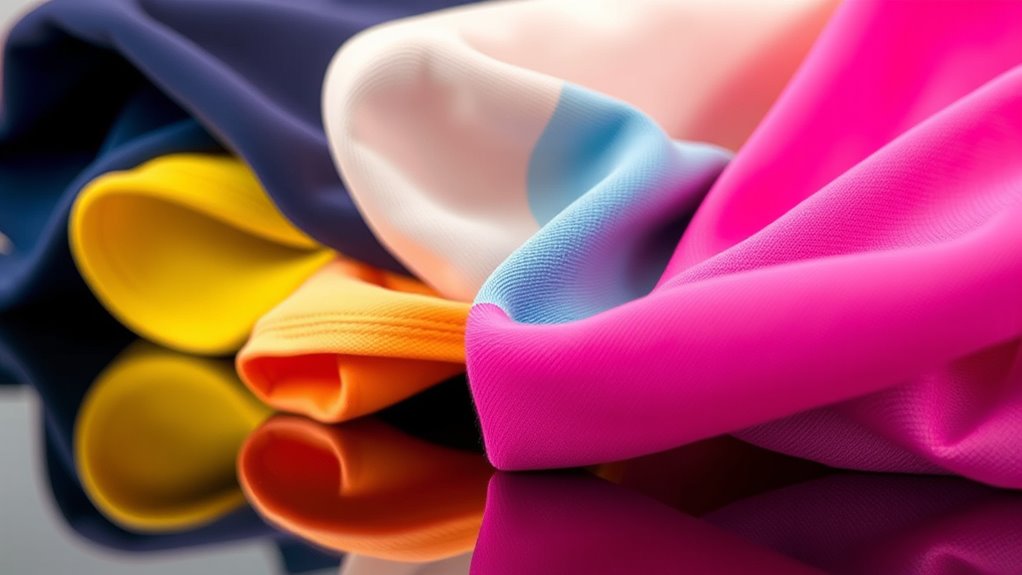To choose the right rash guard, look for fabrics like polyester, nylon, and spandex blends that offer great stretch and recovery. These materials are durable, resistant to pilling and fading, and easy to care for—just rinse with fresh water after use and air dry. For added protection, select options with UV and moisture-wicking features. Keep your gear in top shape by following tips for repairs and maintenance; more expert advice awaits you.
Key Takeaways
- Choose fabric blends like polyester, nylon, and spandex for optimal stretch, flexibility, and recovery in rash guards.
- Opt for high-quality, reinforced stitching and flatlock seams to enhance durability and prevent tears.
- Rinse with fresh water after use and air dry in shade to maintain fabric elasticity and color vibrancy.
- Select fabrics with moisture-wicking, breathability, and UV protection features for comfort and sun safety.
- Repair minor damage with waterproof adhesive or patches, and follow proper washing techniques to extend rash guard lifespan.
Common Rash Guard Fabrics and Their Composition

When choosing a rash guard, understanding its fabric composition is essential because it directly affects comfort, durability, and performance. Most rash guards are made from synthetic fibers like polyester, spandex, or nylon. Polyester offers excellent durability and moisture-wicking properties, keeping you dry during intense activities. Spandex, also known as Lycra or elastane, provides stretch and flexibility, ensuring a snug fit and ease of movement. Nylon is lightweight and strong, often used for its quick-drying features. Many rash guards blend these materials to balance durability, stretch, and comfort. Some fabrics include UV protection or antimicrobial treatments for added functionality. By knowing what your rash guard is made of, you can choose the right one to match your activity level and environmental conditions. Additionally, considering the fabric’s stretch and recovery can help ensure lasting fit and performance over time. Proper care and washing techniques also play a crucial role in maintaining the fabric integrity and extending the lifespan of your rash guard. Choosing fabrics with abrasion and wear resistance is also important, especially for high-contact water sports, to prevent early deterioration and ensure longevity.
Stretch and Flexibility in Rash Guard Materials

The stretch and flexibility of a rash guard are primarily determined by the type and blend of fabrics used. Materials like spandex or elastane are common because they provide excellent elasticity, allowing the garment to move with your body comfortably. When combined with nylon or polyester, these fabrics create a fabric that stretches easily without losing shape or integrity. This flexibility ensures you can perform active movements, like paddling or stretching, without restriction. The right blend offers a snug fit that moves with you, enhancing comfort and performance. Keep in mind, higher elastane content usually means greater stretch, but it can also affect how the fabric recovers after stretching. Choosing the right fabric blend ensures your rash guard remains flexible, supportive, and comfortable during your activities. Additionally, fabric recovery is an important factor to consider, as it determines how well the material returns to its original shape after stretching. Incorporating advanced materials can further improve durability and elasticity, ensuring your rash guard maintains its performance over time. Understanding the fabric technology involved can also help you select a rash guard that maintains its shape and elasticity over time.
Durability Factors for Long-Lasting Rash Guards

Durability in rash guards depends largely on the quality of materials and construction. High-quality fabrics like nylon, polyester, or blends with spandex tend to withstand wear and tear better over time. Look for tightly woven fabrics that resist pilling and fading, especially if you surf or engage in vigorous activities. Reinforced stitching and flatlock seams also play a vital role, preventing tears along stress points. Avoid rash guards with weak or loose stitching, as these are prone to splitting after repeated use. Properly constructed rash guards maintain their shape and elasticity longer, even after multiple washes and exposure to sun, salt, or chlorine. Additionally, choosing fabrics with UV protection properties can enhance their longevity against sun damage. Considering fabric treatment options can further improve durability by making the material more resistant to environmental factors. Well-made rash guards with quality construction are essential for durability, ensuring your gear withstands tough conditions and prolonged use. Investing in well-made gear ensures your rash guard remains durable, providing reliable protection and comfort season after season, especially when selecting sturdy fabrics designed for high-performance activities. For added durability, some rash guards incorporate anti-fade treatments that help maintain color vibrancy over time.
Moisture-Wicking and Breathability Features
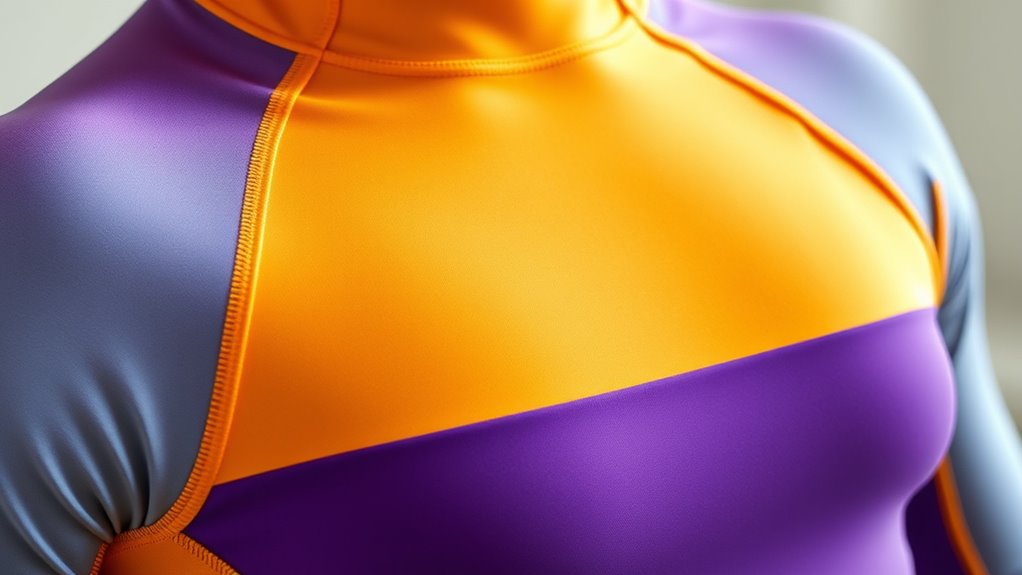
When choosing a rash guard, you want fabrics that effectively wick moisture away from your skin, keeping you dry during active swim sessions. Look for materials with high moisture management efficiency to prevent discomfort and chafing. Additionally, fabrics with enhanced airflow capabilities help promote breathability, so you stay cool even in hot conditions.
Moisture Management Efficiency
Moisture management efficiency is essential in rash guard fabrics because it directly affects your comfort during intense workouts or water activities. When your rash guard wicks sweat away quickly, it keeps you dry and minimizes chafing. Fabrics with high moisture-wicking properties pull moisture from your skin and disperse it across the fabric’s surface, speeding up evaporation. Breathability also plays a role by allowing air to circulate and release heat, helping you stay cool. Look for materials like polyester blends or those with advanced moisture-control treatments. Proper moisture management prevents discomfort, reduces skin irritation, and helps maintain your body temperature. Investing in rash guards with excellent moisture management ensures you stay focused on your activity without distraction or discomfort caused by excess sweat. Additionally, choosing fabrics with moisture-wicking properties can enhance overall performance and comfort during your water and fitness routines. To optimize your rash guard’s effectiveness, consider fabrics that incorporate breathable and quick-drying technologies to enhance comfort further. Incorporating fabrics with antimicrobial treatments can also help reduce odor and bacterial growth, maintaining freshness during extended use. Moreover, selecting materials that feature quick-drying capabilities can further improve your experience by reducing drying time after water exposure. Using fabrics designed with specialized moisture management can further enhance your comfort and durability.
Enhanced Airflow Capabilities
Fabrics designed for enhanced airflow actively boost your comfort by combining moisture-wicking capabilities with superior breathability. They draw sweat away from your skin quickly, keeping you dry during intense activities. These fabrics also feature open-knit structures or mesh panels that allow air to circulate freely, preventing overheating and excess moisture buildup. By promoting better airflow, they help regulate your body temperature, so you stay cool even in hot conditions. This combination reduces chafing and skin irritation caused by trapped sweat or heat. Additionally, AI-driven fabric innovations leverage smart textiles that adapt to environmental conditions, further improving comfort and performance. These advanced fabrics are often made from durable materials that resist wear and tear, ensuring longevity even after frequent use and washing. Moreover, AI detectors contribute to quality control by verifying the authenticity and consistency of fabric products, safeguarding consumers. The incorporation of performance-enhancing features in fabric design ensures that your rash guard remains effective and comfortable throughout your activities. For example, coastal zone fabrics are specially engineered to withstand exposure to saltwater and sun, maintaining their integrity over time. Whether you’re surfing, training, or relaxing, fabrics with enhanced airflow capabilities keep you comfortable and dry, allowing you to focus on your performance. Investing in rash guards with these features ensures you stay cool, dry, and comfortable in any water or outdoor setting.
UV Protection and Sun Safety Attributes

Rash guards are designed to provide essential UV protection, helping you stay safe under the sun. They often feature fabrics with UPF (Ultraviolet Protection Factor) ratings, which block harmful rays and reduce your risk of sunburn and skin damage. The higher the UPF rating, the better your rash guard shields you from ultraviolet radiation. Many rash guards incorporate specialized fibers or treatments that enhance their sun protection qualities without sacrificing comfort or flexibility. Wearing a rash guard with UV protection allows you to extend your time outdoors, whether you’re surfing, swimming, or lounging on the beach. Remember, even with a rash guard, it’s wise to apply sunscreen on exposed skin and seek shade during peak sun hours for all-encompassing sun safety. Additionally, understanding market positioning strategies can help you choose rash guards that stand out in a competitive outdoor apparel market. Incorporating fabric technology that enhances breathability and durability can further optimize your rash guard’s performance and longevity. Being aware of performance fabrics can ensure your rash guard maintains its protective qualities through repeated use and washing. Furthermore, selecting fabrics with integrated UV protection can provide an extra layer of defense against harmful rays, ensuring your sun safety is maximized.
Care and Maintenance to Prolong Fabric Life
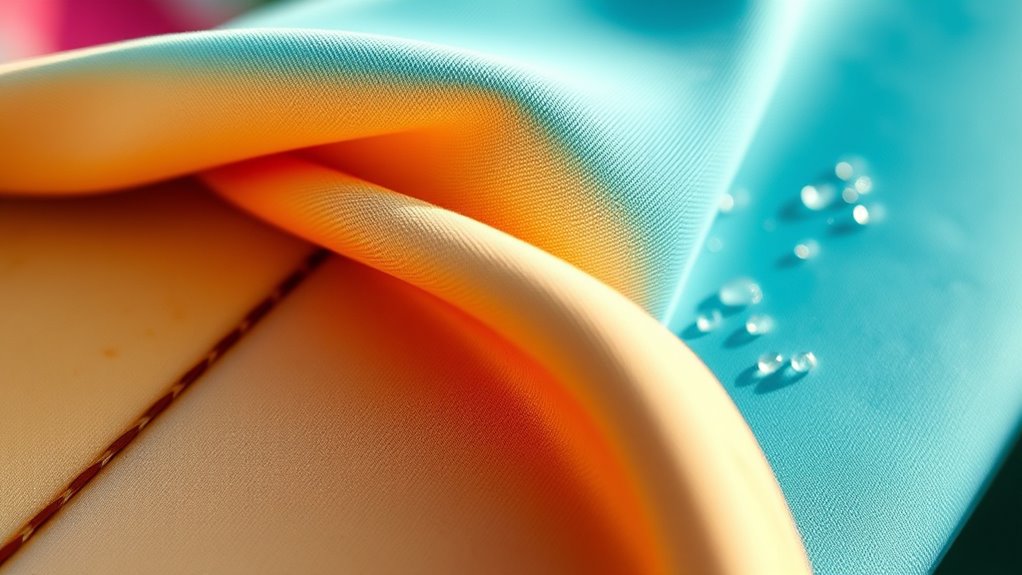
To keep your rash guard in top shape, always rinse it thoroughly after each use. Use proper washing techniques to prevent fabric damage and maintain its performance. Taking these simple steps can considerably extend the life of your rash guard.
Rinse After Use
After each use, it’s essential to rinse your rash guard thoroughly with fresh water. Saltwater, chlorine, sand, and sunscreen can all weaken the fabric and cause colors to fade over time. Rinsing promptly removes these residues, preventing buildup that can compromise elasticity and durability. Use cold or lukewarm water, avoiding hot water that may damage the fibers. Gently squeeze out excess water without wringing, which can distort the fabric. Allowing your rash guard to air dry in a shaded area prevents sun damage and fading. This simple step helps maintain the fabric’s stretch and color vibrancy, extending its lifespan. Regular rinsing is a quick, effective way to care for your rash guard and keep it performing well, season after season.
Proper Washing Techniques
Proper washing techniques are essential for maintaining your rash guard’s fabric and extending its lifespan. Always rinse your rash guard with cold water after each use to remove salt, chlorine, and sweat that can weaken the material. When washing, use a gentle detergent free of bleach or harsh chemicals, which can damage the fibers. Hand washing is preferable, but if you machine wash, select a delicate cycle and place the rash guard in a mesh laundry bag for added protection. Avoid wringing or twisting the fabric, as this can cause stretching or damage. Instead, gently squeeze out excess water and lay the rash guard flat to dry in the shade. Following these steps will help preserve its elasticity, color, and overall durability.
Tips for Selecting the Right Fabric for Your Activity
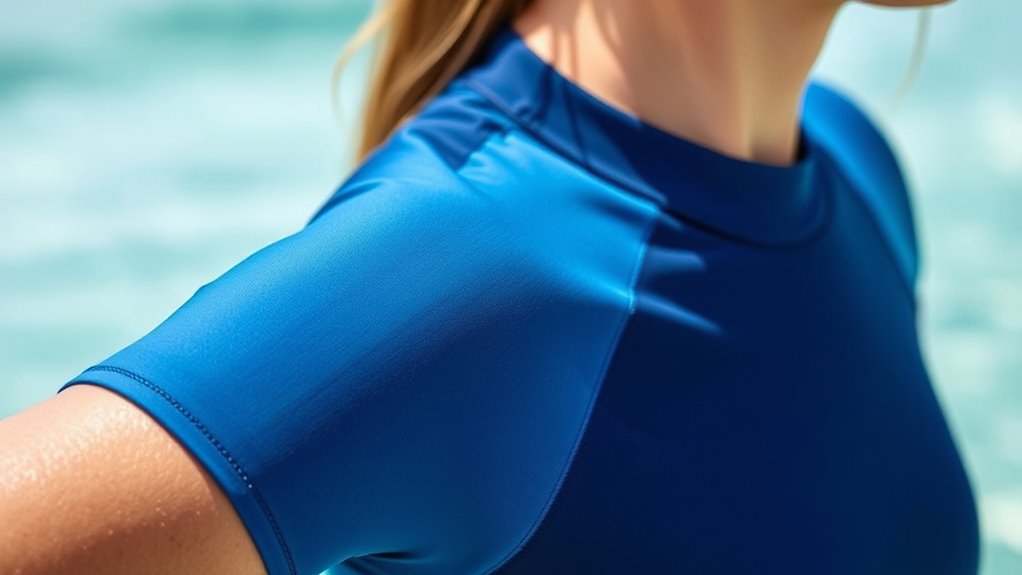
Choosing the right fabric for your activity depends on understanding how different materials perform in various conditions. If you’re surfing or swimming in warm water, look for fabrics with quick-drying and moisture-wicking properties to keep you comfortable. For cold-water activities, prioritize thicker, insulating fabrics that retain heat while still offering stretch for movement. If durability is key, choose fabrics with high abrasion resistance, especially for rugged environments like rock climbing or wakeboarding. Consider UV protection if you’ll spend long hours in the sun—some fabrics have built-in UPF ratings. Breathability is essential for high-intensity workouts, so opt for lightweight, breathable materials. Matching fabric features to your activity ensures comfort, performance, and longevity for your rash guard.
Troubleshooting and Repairing Rash Guard Damage
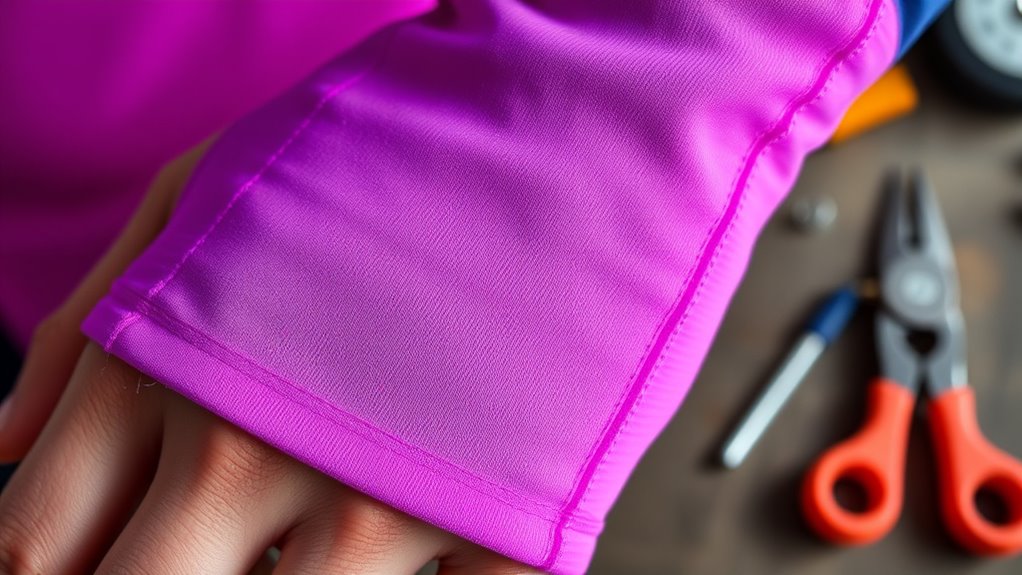
Even the most durable rash guards can sustain damage over time, whether from abrasions, tears, or general wear and tear. When you notice small tears or loose seams, don’t panic. For minor rips, you can apply a waterproof fabric adhesive or use a patch to reinforce the area. Make sure the surface is clean and dry before repairing. For larger tears, consider sewing them with a waterproof, stretchable thread to maintain flexibility. If your rash guard has color fading or stubborn stains, spot cleaning with gentle soap and a soft brush can help restore its appearance. Always follow the care instructions to prevent further damage. Regular maintenance extends your rash guard’s lifespan and keeps it performing well in the water.
Frequently Asked Questions
How Often Should I Replace My Rash Guard for Optimal Performance?
You should replace your rash guard when it shows significant signs of wear, such as loose stitching, thinning fabric, or loss of elasticity, which can affect its performance and protection. Typically, if you use it frequently, consider swapping it out every 1-2 years. Regularly inspect it, and trust your judgment—if it no longer fits snugly or feels less effective, it’s time for a new one to guarantee peak comfort and safety.
Can I Bleach or Use Fabric Softeners on Rash Guard Fabrics?
Thinking about bleaching or softening your rash guard is like trying to tame a wild horse — it can backfire. You shouldn’t use bleach or fabric softeners because they can weaken the fabric and damage the material’s elasticity. Instead, stick to gentle detergents and cold water. This helps keep your rash guard stretchy, durable, and in top shape for all your water adventures.
Are There Specific Washing Machines or Cycles Best for Rash Guards?
You should choose a gentle washing cycle on your machine for rash guards. Use cold water to prevent damage or color fading. Avoid heavy-duty cycles, as they can cause stretching or wear. If possible, opt for a delicate or hand-wash setting. Always turn your rash guard inside out, and avoid using fabric softeners or bleach to keep the fabric’s stretch and durability intact.
How Do I Prevent Pilling and Fading Over Time?
Did you know that improper care can cause rash guard pilling and fading within just a few months? To prevent this, always wash your rash guard inside out on a gentle cycle with cold water. Avoid harsh detergents and fabric softeners, and air dry instead of using a dryer. These simple steps help maintain the fabric’s stretch, color, and overall look, keeping your rash guard looking new longer.
What Are Eco-Friendly Options for Rash Guard Fabrics?
When choosing eco-friendly rash guard fabrics, you should look for options like recycled polyester, organic cotton blends, or bamboo-based fabrics. These materials reduce environmental impact and often come from sustainable sources. You can also select brands that prioritize eco-conscious manufacturing. Always check labels for certifications like GOTS or OEKO-TEX, ensuring the fabric’s sustainability. By making mindful choices, you help protect the environment while enjoying durable, comfortable rash guards.
Conclusion
Choosing the right rash guard fabric guarantees comfort, durability, and sun protection during your water adventures. Did you know that high-quality fabrics can last up to twice as long with proper care? By understanding fabric composition and maintenance tips, you’ll maximize your investment and stay protected. Remember, investing in the right material not only enhances your performance but also keeps you safer in the sun. Stay informed, stay protected, and enjoy every splash!

